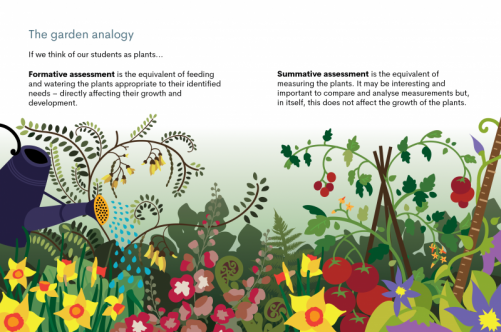You are here:
- Home »
- Using evidence for learning »
- Gathering evidence »
- Formative and summative assessment
Formative and summative assessment
Summative assessment is intended to summarise student achievement at a particular time, whereas formative assessment is intended to promote further improvement of student attainment (Crooks, 2001). However, summative assessment can also be used formatively, if it provides feedback to the student, teacher, school leader, Board of Trustees or Ministry of Education, to lead to further improvement.
In the garden analogy formative assessment ascertains and provides for the needs of the plants to help them grow, while summative assessment merely measures the plants and provides information about how much they have grown.
Formative assessment is educational measurement that is used to inform the teaching and learning process. Ideally, both the teacher and the student will gain information from the assessment and use it collaboratively to plan future learning activities. The important thing in formative assessment is to gain as much information as possible in respect of what the student has achieved, what has not been achieved, and what the student requires to best facilitate further progress.
A good teacher practises formative assessment constantly on an informal basis through classroom observation and interaction. At its most informal level, formative assessment can be a conversation between a teacher and a student. As this type of assessment is low stakes, there is less need to establish processes to ensure the reliability of the assessment.
Assessment can be thought of along a formative/summative continuum. Teacher/student conversations are at the formative end of the continuum, and assessment used for credentialing is at the summative end.
Summative assessment is measuring the outcome of an educational programme for the students who participated in that programme; that is, what skills and knowledge, relevant to the programme, do they have at the conclusion of the programme. Although it is desirable to use the results to inform further learning, for example, results from end-of-year assessment are used to inform programmes for the following year, it is typically the results of the assessment that are the primary focus of attention.
Summative assessment is typically used for reporting to parents and whānau, credentialling (awarding of qualifications), selection (for jobs or university places, for example), or as accountability measures for educational providers. Because all of these purposes involve outcomes with, to a greater or lesser degree, high stakes for individuals or providers, the fairness of the assessment process is a very important concern.
Because summative assessments often have high stakes, they can have a blowback effect on teaching and learning; there can be pressure on the educator to narrow the focus of teaching to ensure good performance in the assessment. Students can similarly narrow their focus, or lose intrinsic, curiosity-driven motivation as they become concerned about the consequences of a poor assessment outcome.


